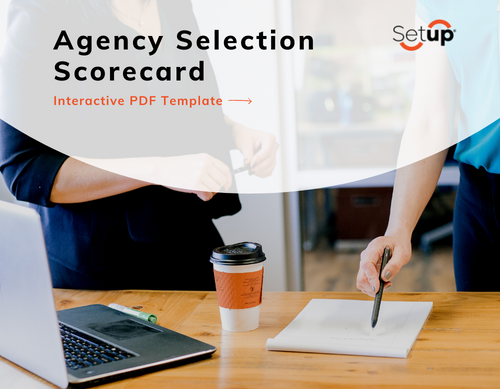A How-to Guide to Writing the Perfect Marketing Brief
A well-formatted brief can make or break a marketing campaign. The brief provides a solid foundation to ensure that an internal or external team is aligned to execute the strategy. If choosing an external team via the RFP process, writing a detailed marketing brief is absolutely essential.
At Setup, our vision is to connect marketers with the best people and resources. Check out some of our free resources below, and see how we can further assist you here.
A marketing brief should accomplish 4 critical points for the team:
Explain the purpose of a given marketing strategy
Detail the measurements that will determine the success of a campaign
Identify the audience and expected outcomes of the project
Set clear goals, timelines, and responsible parties for the marketing campaign
Before constructing a marketing brief...
Go over expectations with the creative team and stakeholders. If everyone knows the purpose of their contributions to the overall project, then quality work will ensue.
Avoid jargon, lingo and acronyms.
Remember to keep it simple but as detailed as possible.
During the process of creating a marketing brief...
Constantly ask What, Why, Who, How, and When - details, details, details!
Continually make the content engaging, relevant, clear, and factual. Since this brief is shared with the entire staff (and, in some cases, external parties), it is vital that the material is clean and concise to ensure the project’s success.
Every decision made should tie back to the overall goal of the project.
Building the brief...
Three overall guidelines to follow: Define, Plan, and Evaluate.
A Step-by-Step Guide to Creating a Marketing Brief:
Define
Background. Give a summary of product/brand/services. What are the core values of the company? What is the personality, philosophy or mission statement of the brand? What is the brand's voice? Be as detailed as possible so that not only internally staffed members fully understand the purpose or existence of the business, but external parties like stakeholders, directors, ad agencies, and copywriters are fully informed. Detail pricing and selling processes as well. Describe the current situation.
Objective. Align priorities of the company. Why is this campaign beneficial and how will it advance the productivity of the brand/product? What is the overall goal of the campaign and what are the risks associated with it? What is this campaign supposed to communicate? Have the business' insights in mind.
Budget. Determine the budget range for the marketing plan. Download our free marketing budget template.
Target Market. Is this marketing proposal targeted towards consumers (BtoC) or other businesses (BtoB)? How will the market be segmented and how will the product serve the given target audience? What type of consumer persona is interested, what is the consumer's personality type, and what data can be used to best cater to their needs? What factors influence purchase decisions? What are the barriers delaying a certain purchase? How can a company streamline the purchasing process? Are there generational marketing factors - Millennial or Generation Z?
Competition. Describe the current market. What competing products are successful and why? Include other brands’ successes and failures. How are competitors marketing to public and what can be done to stand out next to them? What insights are valuable?
Stakeholders. List everyone involved in the campaign and their responsibilities. (Who is in charge of design? Who is in charge of executing each marketing activity? Who will keep the creative team on the right timeline?) It is helpful for the staff to know what relationships are at risk and who their work is benefiting?
Mandatories. Clearly list the guidelines, terms and conditions, legal requirements, project deliverables, and disclaimers. All expectations should be laid out on the table so that there aren't any surprises. The brand’s tone and call to action are important to convey throughout the brief as well.
Plan
Channel. Since data about the target market is already gathered, determine which channel is best to reach them, as well as the overall marketing mix. The right mix will depend on the marketing strategy and will likely involve email marketing, social media, organic or paid search, printed or website deliverables or even TV media. Determine the destinations/channels of the deliverables: where will they live, on the website, on a blog, on partner sites, YouTube, or TV? Where will these marketing ads take the consumer and how will it impact the initiative’s ultimate goal? How will this campaign be executed? Is an omni-channel marketing strategy being considered?
Time. Plan the launching of the campaign. Is it seasonal? Figure out the soft and hard deadlines. What are the major milestones that need to be completed with the campaign?
Budget. After planning the execution, map out the expenses and compare it to the initial budgeting framework.
Evaluate
Measure. Outline certain measures of success and expectations (key performance indicators - KPIs - quantitative and qualitative goals, etc). Once the project is complete, a post-mortem should be conducted by the project leader to compare predictions to actual results to determine if the campaign reached its full potential.
NOTE...
Marketing briefs are different from creative briefs!
Marketing Campaign Brief: This document states what the client would like the promotional campaign to achieve and is effectively the instructions for the team writing the promotional campaign.
Creative Brief: This is a document that the team writing the promotional campaign gives to an internal team or agency in response to the campaign brief. The creative brief states the ideas and information for the promotional campaign.
Want to get the perfect marketing brief? Setup created a perfectly comprehensive, detailed marketing brief template available here.



































Setup CEO + Founder, Joe Koufman, sat down with Ron McMurtrie, the CMO of Honeywell, to talk about purpose-driven leadership, having a team-focused mentality, starting with why, and more.